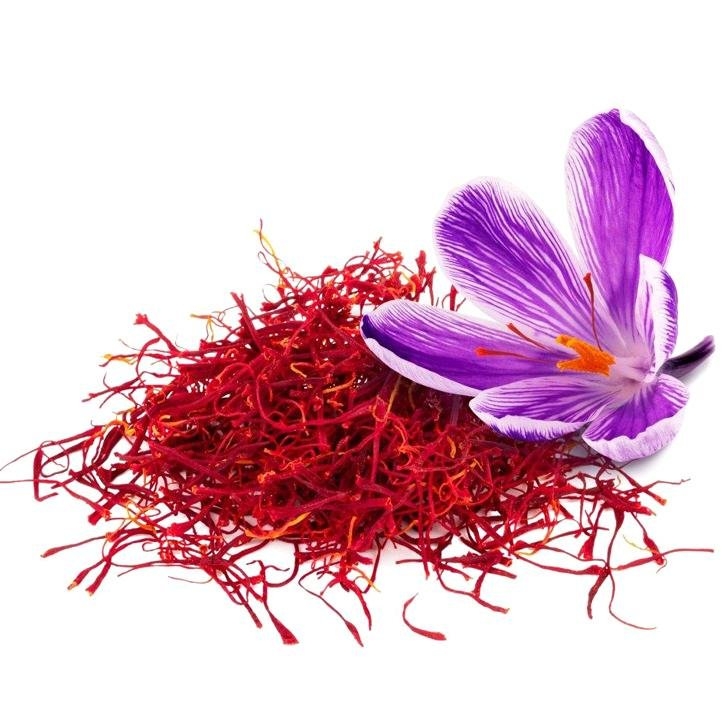It is a perennial bulb mainly found in Europe and Asia and is widely cultivated in Iran, Mediterranean countries (specially in the region of Kozani in Greece) and India.
It is a perennial, bulbous herb with deciduous aerial structures. Its bulb is solid, normally subspherical, ovoid, symmetric, occasionally stoloniferous, in other words, that produces runners or side shoots that may take roots and result in another independent individual. Leaves are all basal, bifacial, sometimes absent or enclosed in pods in the anthesis, linear, with two furrows in the lower side and flat in the upper side. They are surrounded by a tubulous pod in the base, which is formed by several membranous cataphylls (modified and reduced leaves that are characteristic of the subterranean organs such as bulbs and rhizomes that protect plant buds).
Its inflorescence has one or several independent flowers. Its flowers are hermaphrodite, actinomorphous, erect, each one on a short hypogeal pedicel, sometimes protected by a membranaceous bracteole. Campanulate, regular perianth with connate pieces in its base forming a long and narrow tube, which may be glabrous or may have a hairy ring in the throat, next to the insertion area of filaments; tepals are usually shorter than the tube, from oblanceolated to obovate, and in general subequal. Flower style is filiform and ramifies in 3 long serrated and entire stigmas of an intense reddish color. Equilateral and free stamen, consolidated to the mouth of the perianth tube; linear, usually extrorse, basifixed anthers. Tricarpillary and trilocular, subterranean ovary. Its fruit is in a cylindrical or ellipsoidal capsule and ripens at ground level or on it. Its seeds are numerous, globular, ellipsoidal or pyriform, in general brown or reddish.
As its three stigmas are the most valued part and must be manually recollected, saffron is the most expensive spice in the world and is called the “red gold” in Iran. Saffron is widely used in food and pharmaceutical industry and is used in medicine and in perfume industry.
Part used
Saffron is constituted by stigmas and dried style endings (Stigma croci). Petals are used too.
Eirin Christodoulou, Nikolaos PE Kadoglou, Nikolaos Kostomitsopoulos, Georgia Valsami. Saffron: a natural product with potential pharmaceutical applications. Journal of pharmacy and pharmacology. 2015 Dec; 67(12):1634-49
Tóth B, Hegyi P, Lantos T, Szakács Z, Kerémi B, et al. The Efficacy of Saffron in the Treatment of Mild to Moderate Depression: A Meta-analysis. Planta Med. 2018 Jul 23.
Kashani L, Esalatmanesh S, Eftekhari F, Salimi S, et al. Efficacy of Crocus sativus (saffron) in treatment of major depressive disorder associated with post-menopausal hot flashes: a double-blind, randomized, placebo-controlled trial. Arch Gynecol Obstet. 2018 Mar; 297(3):717-724.
Wang H et al. Antidepressant properties of bioactive fractions from the extract of Crocus sativus L. J Nat Med 2010; 64: 24–30.
Akhondzadeh S et al. Saffron in the treatment of patients with mild to moderate Alzheimer’s disease: a 16-week, a randomized and placebo controlled trial. J Clin Pharm and Ther 2010; 35: 581–585.
Broadhead GK, Grigg JR, McCluskey P, et al. Saffron therapy for the treatment of mild/moderate age-related macular degeneration: a randomised clinical trial. Graefes Arch Clin Exp Ophthalmol. 2019 Jan;257(1):31-40. Assimopoulou AN et al. Radical scavenging activity of Crocus sativus L. extract and its bioactive constituents. Phytother Res 2005; 19: 997–1000.
